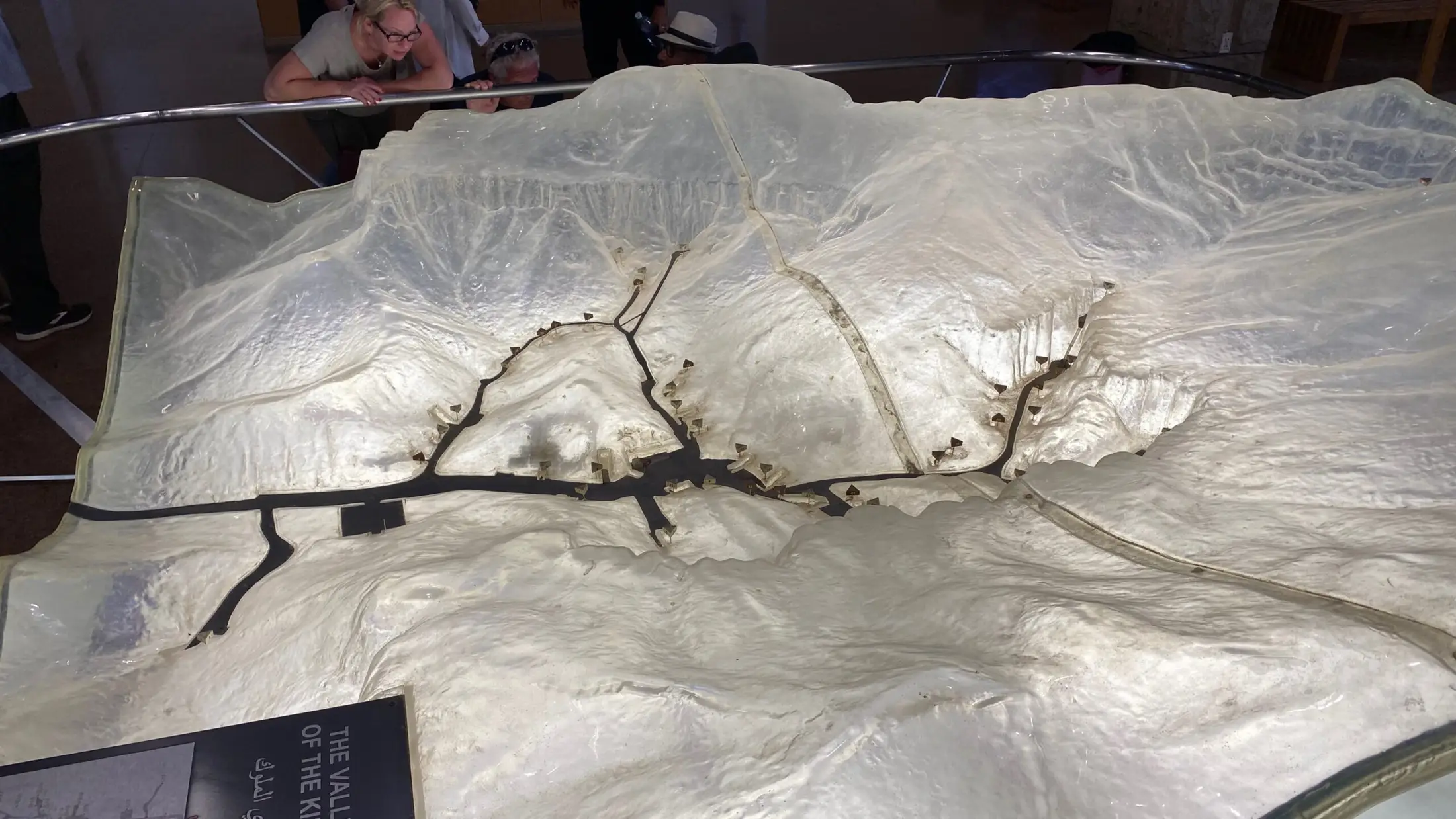Egyptian Ancient History
The Valley of the Kings was probably first introduced to us in elementary school. It might have been in the 6th Grade. But who knows because that was a long time ago. Egyptian Ancient History, however, just did not resonate. I do not remember the Valley of the Queens. In 1976 when the “Treasures of Tutankhamun” began a 6 American cities, 3 year tour, Egyptian history became a fascination for us and millions of other Americans. People lined up for hours to see the exhibits. Museums became the hottest tickets in town. King Tut has played an outsized role in our cultural imagination ever since. In November we finally made it to the Valley of the Kings. We also visited the Valley of the Queens because it is where the Tomb of Nefertari is located. It only took a mere 50 years to experience these tombs.
Egyptian Empire
Pharaohs are buried in the Valley of the Kings. The Valley of the Queens contains the tombs of the Pharoah’s wives. Burying the tombs in each valley only occurred during the five centuries starting in the sixteenth century BCE and ending in the eleventh century BCE. The Egyptian Empire is an another name for this time period because it marked the peak of Egypt’s power and wealth. The pyramids were from a different, less affluent era, because they were constructed more than 1,000 years before the Egyptian Empire and the Valley of the Kings.
The Nile River

The Valley of the Kings and the Valley of the Queens are located in the greater Luxor Governorate. They are on the west side of the Nile River, directly across from the Temple of Karnak. It is only a 40 minute drive from the Steigenberger Nile Palace Hotel in the City of Luxor, where one can experience stunning views of the Nile River. As we approach the area of the valleys, the landscape changes. Towering cliffs and barren hillsides replace the lush vegetation along the banks of the Nile.
European Discovery of The Valley of the Kings
The first European to search for the hidden tombs in the Valley of the Kings was an Italian explorer, Giovanni Belzoni. He discovered 30 tombs in the mid 19th century only to find they all had been looted.

Ernesto Schiapolli, another Italian explorer, discovered the Valley of the Queens a few years after Belzoni’s discovery. The Valley of the Queens is about two miles south of the Valley of the Kings.
In the 20th century, the excavation of the tombs continued under the guidance of several notable archaeologists, including Howard Carter. Howard Carter, a British archaeologist and Egyptologist, discovered the intact tomb of the 18th Dynasty Pharaoh Tutankhamun in November 1922. King Tut’s tomb was the best-preserved pharaonic tomb ever found in the Valley of the Kings. This discovery pushed the Valley of the Kings into the international limelight and sparked public fascination with ancient Egypt.
Our Visit to The Valley of the Kings

The Valley of the Kings is an awe-inspiring sight to behold, with its neatly arranged rock-cut tombs, each one marked with the name and titles of the pharaoh buried inside. Over sixty tombs have been discovered in the Valley. Only a handful are open to the public. Each tomb is unique in its design and decoration, with intricate hieroglyphics, vibrant colors, and stunning reliefs that tell the story of the pharaoh’s journey to the afterlife. In the Valley of the Queens over 90 tombs have been discovered. Queen Nefertai’s tomb is by far the best one. It is very detailed, large and in very good condition.
Our trip to the Valley of the Kings and the Valley of the Queens begins early in the morning. The sun is just starting to rise, and the air is cool and refreshing. As we walk towards the entrance of the Valley, we feel a sense of awe and reverence. This is a place steeped in thousands of years of history and tradition. We are exploring some of its greatest treasures. Of course, first we traverse though the maze of ubiquitous and relentless trinket hawkers.
Nefertari
The Tomb of Nefertari is our first stop in the Valley of the Queens. She is the first and favorite wife of King Ramses II. Of all the tombs in Egypt this tomb is considered one of the most well-preserved and exquisite. Stunningly beautiful paintings and intricate hieroglyphics adorn the walls. We are struck by the sheer size of the paintings and the incredible level of detail. It is almost overwhelming, but in the best possible way. We spend time exploring the tomb, learning about Nefertari’s life and legacy, and admiring the intricate artwork that adorned its walls.
Seti I
The Tomb of Seti I is our first stop in the Valley of the Kings. Seti I is the father of Ramses II. One of the longest and most complex tombs in the Valley. Seti I’s tomb is also one of the best for seeing the evolution of tomb design and decoration throughout Egypt’s history. From the intricate reliefs depicting Seti’s divine lineage to the vividly painted scenes of the afterlife, this tomb is a true feast for the senses. We spend quite a bit of time wandering its dark passageways and marveling at its impressive architecture.
King Tut
Finally, we arrive at the Tomb of King Tutankhamun. He is the child king who ascended to the throne at age 9. He died at age 19 after a reign of only 10 years. This tomb is easily the most famous of all the tombs in the Valley, and for good reason. King Tut’s tomb was packed with incredible treasures even though it is relatively small. The treasures including the gold-plated chariots, exquisite jewelry and even the famous golden mask now resides in the Egyptian Museum in Cairo. As we walk through the tomb, we could feel a sense of wonder at the sheer opulence and wealth of ancient Egyptian royalty.
Travel is Rewarding
Travel, especially to those places outside our comfort zone, is very rewarding. It gives us a much better appreciation of other cultures and what they endure in their every day lives. It helps us understand the despair that might lead to social unrest. Egypt has certainly had some extreme ups and downs over its history. Hopefully, continued tourism to the Valley of the Kings, the Valley of the Queens and the Temple of Karnak in the Luxor area will improve the living conditions for those in need. There are quite a few other notable sites worth touring in the area including the Temple of Hatshepsut and the Colossi of Memnon.
We were not prepared for the overwhelming poverty we witnessed on the way to the Valley of the Kings. The poverty rate is more than 60% in the Luxor area despite it being one of the top destinations for tourists in Egypt.








